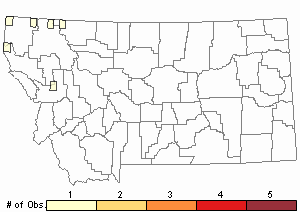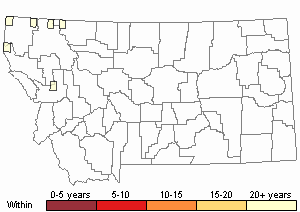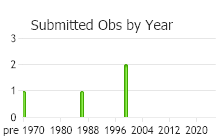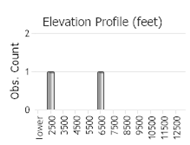View in other NatureServe Network Field Guides
NatureServe
Montana
Utah
Wyoming
Idaho
Wisconsin
British Columbia
South Carolina
Yukon
California
New York
A Dicranum Moss - Dicranum pallidisetum
General Description
Plants: Acrocarpous. Growing in uncrowded clumps of erect shoots, shiny or not, yellowish or deep green. Stems 1-6 cm tall; rhizoids pale or russet and thickly covering the stem with woolly matting (FNA 2007).
Leaves: Frequently curled or twisted when dry, smooth, strongly curved to the side to almost straight when moist, not wavy (Lawton 1971), lance-shaped and tube-shaped, narrowing to the acute leaf tip, 4-8 mm in length, 0.5-1 mm in width; margins saw-toothed distally, smooth below; costa extending beyond the apex, with papillae or teeth dorsally from mid-leaf to the apex, lacking dorsal crests (FNA 2007).
Leaf Cells: Lamina 1 cell-layer thick, the cells smooth or frequently bearing papillae in the upper leaf half, the walls between the cells only bulging a little or not at all; upper margins rarely with 2 cell-layers; upper laminal cells square, short and quadrangular, or sometimes oddly angled or angles smoothed, not porose; lower laminal cells quadrangular (FNA 2007) to very thin (Lawton 1971), porose or not; alar cells distinct, inflated, frequently reaching the costa, the alar region 2 cell-layers thick; costa in X-section usually with strong ventral and dorsal stereid bands below but missing from the upper 1/4 or so, and 1 guide cell row, the cells on top of and below the guide cells big and fine-walled (FNA 2007).
Phenology
Fruit ripens in summer (FNA 2007).
Diagnostic Characteristics
Sometimes mistaken for D. fuscescens. D. fuscescens prefers lower elevations, usually below 2620 feet, rather than higher ones like D. pallidisetum (infrequently growing between 1640 and 2620 feet). D. fuscescens has leaves slowly tapering to a deeply folded, subulate apex rather than a tube-like distal portion, and stereid bands reaching the apex rather than than vanishing ca 1/3 of the leaf distance below the apex (FNA 2007). The stereid bands of the similar D. muehlenbeckii also reach the apical part of the leaf (Lawton 1971).
Range Comments
North American Range
Canada: BC and AB; USA: AK, WA and OR, e to MT (FNA 2007). Known in Montana from Flathead, Glacier, Lincoln, and Mineral Counties (Elliott 2016).
Observations in Montana Natural Heritage Program Database
Number of Observations: 8
(Click on the following maps and charts to see full sized version)
Map Help and Descriptions
Relative Density

Recency



 (Observations spanning multiple months or years are excluded from time charts)
(Observations spanning multiple months or years are excluded from time charts)
Reproductive Characteristics
Diocious. Inner perichaetial bracts enveloping the stem, suddenly narrowing to the short acumen. Seta mostly single, occasionally paired, and seldom 3 in a perichaetium, yellow, seldom acquiring red or brown tones over time, 10-25 mm tall. Capsule bowed and tilted, constricted below the opening, deeply ridged when dry, yellow to ochre, seldom acquiring red or brown tones over time, 1.5-3.5 mm in length (FNA 2007); operculum similar in length to the theca (Lawton 1971); peristome of 16 teeth, separated ca halfway down into 2 lobes (seldom 3), russet, with papillae above. Calyptra hood-like, hairless, sheltering much of the capsule, falling away easily (FNA 2007).
Stewardship Responsibility
References
- Literature Cited AboveLegend:
 View Online Publication
View Online Publication Elliott, J.C. and A.K. Pipp. 2018. A Checklist of Montana Mosses (1880-2018). Updated 3 January, 2020. Montana Natural Heritage Program, Helena, Montana. 73 pp.
Elliott, J.C. and A.K. Pipp. 2018. A Checklist of Montana Mosses (1880-2018). Updated 3 January, 2020. Montana Natural Heritage Program, Helena, Montana. 73 pp. Flora of North America Editorial Committee, eds. 2007. Flora of North America North of Mexico. Volume 27. Bryophytes: Mosses, Part 1. Oxford University Press, Inc., NY. xxi + 713 pp.
Flora of North America Editorial Committee, eds. 2007. Flora of North America North of Mexico. Volume 27. Bryophytes: Mosses, Part 1. Oxford University Press, Inc., NY. xxi + 713 pp. Lawton, E. 1971. Moss Flora of the Pacific Northwest. Hattori Botanical Laboratory. Japan: Yamabuki-cho, Shinjuku-ku, Tokyo. 362 pages plus appendices.
Lawton, E. 1971. Moss Flora of the Pacific Northwest. Hattori Botanical Laboratory. Japan: Yamabuki-cho, Shinjuku-ku, Tokyo. 362 pages plus appendices.
- Additional ReferencesLegend:
 View Online Publication
View Online Publication
Do you know of a citation we're missing? Elliot, J. C. 1993. Second checklist of Montana mosses. Unpublished report. U.S. Forest Service, Region 1. Missoula, MT. 45 pp.
Elliot, J. C. 1993. Second checklist of Montana mosses. Unpublished report. U.S. Forest Service, Region 1. Missoula, MT. 45 pp. Lawton, E. 1971. Keys for the Identification of the Mosses on the Pacific Northwest. Reprinted from 'Moss Flora of the Pacific Northwest'. Published as Supplement No. 2 of the Journal of the Hattori Botanical Laboratory. Nichinan, Miyazaki, Japan. 66 pp.
Lawton, E. 1971. Keys for the Identification of the Mosses on the Pacific Northwest. Reprinted from 'Moss Flora of the Pacific Northwest'. Published as Supplement No. 2 of the Journal of the Hattori Botanical Laboratory. Nichinan, Miyazaki, Japan. 66 pp.
- Web Search Engines for Articles on "A Dicranum Moss"





